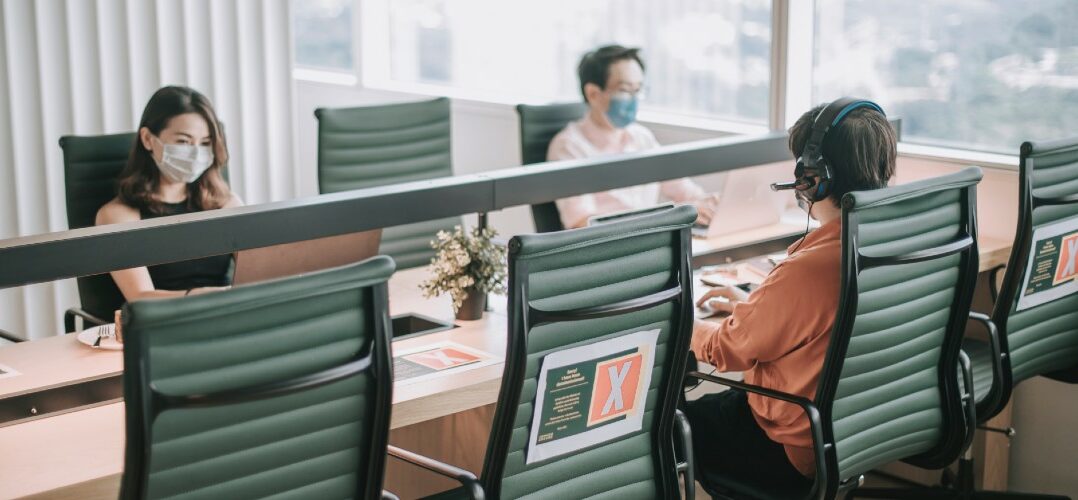Cisco is a large company that hosts over 140,000 employees and inhabits 460 buildings worldwide. Prior to the pandemic, the company was moving away from the traditional, cubical-based office layout, and towards more spaces to “concentrate, collaborate, learn, and socialise.” Their offices were beginning to look more open, with a large focus on supporting in-person collaboration.
However, when the pandemic struck, this had to be reimagined yet again. Miller says, “space design, technology, and policy and culture all have to come together. And arguably, that means that IT, real estate, and HR have to come together.” Using this concept that success requires alignment, Cisco embarked on a mission of supporting employees, and making sure they feel safe at every stage of this crisis.
Phase One: Survive
Miller determines that the first phase of approaching a pandemic-stricken world, is survival.
“Our focus was really on care and comfort.” At Cisco, this meant preserving business operations and supporting employees. The company sought to ensure that work-from-home was not only feasible, but as successful as possible.
Including technologies to support this goal was key to employee success. The main technologies that were implemented in stage one were, work-from-home enablement, secure access, platforms to support preserve and support team collaboration, employee communications, and distance learning. The company also hosted online check-in calls, that were highly attended by employees.
The outcome of these new systems and procedures that surrounded care and comfort, was the alleviation of fears, and proof that employees could be productive outside of the workplace.
However, Miller says the main challenge during this time was, “having an effective environment to work from home was a struggle. They didn’t have the space. . . They really missed the casual collaboration. All collaboration was scheduled. What they missed was the dark spaces. The conversations that happened in the hallway.” Additionally, he says that it was difficult to engage introverted employees into virtual conversations, since a lot of their communications happened outside of meetings.
Challenges also appeared with new hires, as the importance of sharing tacit knowledge was recognized: “the workplace is really important for them to not only pick up information, but to build a network and understand reputation capitol. Those things are really difficult to attain when you are working virtually.”
Phase Two: Revive
Miller believes that the second phase “will happen for a very long time, probably 18-24 months. Well past any vaccine.”
The revival phase focuses on adapting to the new normal, with controlled use of the workplace.
Technologies should be implemented to complement the following technological trends: the growth of video collaboration, hands-free tech, contextual/personalized information, basic wayfinding, workplace utilization analytics, and automating facilities.
These technologies seek to keep offices safe through increased video conferencing, no-touch surfaces, and wayfinding so that employees can take efficient, low density routes around the office. Technologies that monitor and track paths will be used to create routes for each employee to take so that they can avoid groups of people.
Additionally, training platforms will be utilized to ensure that employees are up to date with new procedures.
Miller says that “everyone will go through online training to establish the baseline for what the safe measures are that we all need to take to be corporate citizens. But also, very specialized training, things we need to know per geography. When you take that training, that will make your badge active to actually go into the office.”
When employees go into the office, they will use an app to conduct a pre-screening at home to evaluate any potential symptoms of the virus. The app will determine if they can enter the building and unlock their badge if they pass the screening.
Inside the office, digital signage will be utilized to keep employees informed with the most recent information. In order to achieve this heightened communication, content will also be sent out to people’s devices.
Video technology will be used in rooms to count the number of people present and alert the group if they are over the limit. When the room is empty, the sensors will create a service ticket for it to be cleaned.
Miller says that this phase is about “setting thresholds and being able to manage those thresholds. . . to make things known to the population.”
In terms of office layout, employees will be given designated workspaces for the day, eliminating hotdesking. However, Miller says “we are not dramatically changing our workplace environment because of COVID. We were leaning towards an open environment based on lots of places to collaborate. We still think that’s what people want when they come to the workplace. We just need to make some accommodations to make sure people feel safe going there.”
Phase Three: Thrive
The last phase consists of responding to a post-pandemic world, Miller says that “the behaviors we’ve learned from this pandemic will long outlive the crisis itself.” This final phase is about the intelligent use of new systems and behaviors.
Technologies will be used for richer virtual experiences, contact tracing, concierge services, knowledge capture, intelligent wayfinding, and healthy building technology. The focus will be on workflow: “we are going to have to rethink not only where people work or how they work, but how work gets done. Rethinking how work flows through a business.”
Miller says that the outcome of technologies used in this phase will be optimised commercial real estate portfolios, access to new talent pools, and embracing new sources of talent. Since work has largely shifted to a virtual world, companies do not have constraints over hiring employees in different geographic areas.
The main lessons from Miller’s informative discussion are that the behaviour changes will long outlive the crisis, adaptability and flexibility will rule, the workplace will remain as the destination for collaboration but will need to work a lot harder, physical and virtual workplaces will be blended, and that this time is in an “are of constantinnovation and ideation.”
Top Image: Getty Images – chee gin tan



